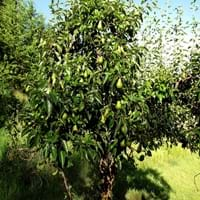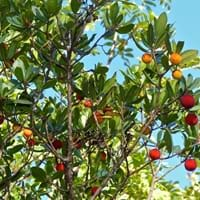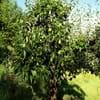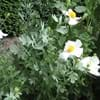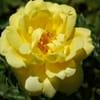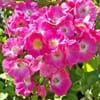Life Span
Perennial
Perennial
Origin
Europe, Western Asia
Mediterranean
Types
Green Anjou, Red Anjou, Bartlett
Not Available
Number of Varieties
Not Available
Habitat
Humid climates, moist forests
limestone outcrops, Rocky areas, Woodlands
USDA Hardiness Zone
3-8
8-9
Sunset Zone
2a, 2b, 3a, 3b, 4, 5, 6, 7, 8, 9, 14, 15, 16, 17, 18
8, 9, 14, 15, 16, 17, 18, 19, 20, 21, 22, 23, 24
Habit
Oval or Rounded
Upright/Erect
Flower Color
White
White, Light Pink
Flower Color Modifier
Not Available
Bicolor
Fruit Color
White, Yellow, Red, Green, Yellow green
Yellow, Red
Leaf Color in Spring
Light Pink, Red, Green, Light Green
Dark Green
Leaf Color in Summer
Dark Green
Dark Green
Leaf Color in Fall
Purple, Dark Green, Burgundy
Dark Green
Leaf Color in Winter
Light Green
Dark Green
Leaf Shape
Oval with a pointed tip and fine teeth along their edges
Orbiculate
Plant Season
Early Spring, Winter
Spring, Summer, Fall, Winter
Sunlight
Full Sun
Full Sun, Partial Sun
Type of Soil
Loamy, Sandy
Loam, Sand
The pH of Soil
Acidic
Acidic, Neutral
Soil Drainage
Well drained
Well drained
Bloom Time
Fall, Summer
Spring, Late Spring, Early Summer, Summer, Late Summer, Early Fall, Fall, Late Fall
Tolerances
Drought
Drought
Where to Plant?
Ground
Ground
How to Plant?
Grafting, Seedlings
Seedlings
Plant Maintenance
Low
Medium
Watering Requirements
Medium, Water less during winter, Water more in summer, when new, water every week
Requires regular watering
In Summer
Lots of watering
Lots of watering
In Spring
Moderate
Moderate
In Winter
Average Water
Average Water
Soil pH
Not Available
Acidic, Neutral
Soil Type
Not Available
Loam, Sand
Soil Drainage Capacity
Not Available
Well drained
Sun Exposure
Full Sun, Partial Sun
Full Sun, Partial Sun
Pruning
Remove damaged leaves, Remove dead branches, Remove dead leaves
Prune in early spring, Prune in late winter, Remove damaged leaves, Remove dead branches, Remove dead leaves
Fertilizers
Ammonium Nitrate, Fertilize the soil before planting
All-Purpose Liquid Fertilizer
Pests and Diseases
Red blotch
Red blotch
Plant Tolerance
Drought
Drought
Flower Petal Number
Single
Single
Foliage Texture
Medium
Medium
Foliage Sheen
Glossy
Glossy
Attracts
Aphids, Birds, Butterflies, Pear psylla
Hummingbirds
Allergy
Anaphylaxis, Digestive Problems, Itchiness, Swelling
Hay fever, Oral Allergy, Skin irritation
Aesthetic Uses
Cottage Garden
Beautification, Showy Purposes
Beauty Benefits
Good for skin, Improve skin tone, Making cosmetics, Moisturizing, Skin Problems
Not Available
Environmental Uses
Air purification, Shadow Tree
Air purification
Medicinal Uses
Cancer, Cardiovascular problems, cholesterol-lowering, Detox, Diabetes, Energy, Fiber, Heart problems, High blood pressure, Obesity, Treating diverticulosis, Weight loss
Antioxidants
Part of Plant Used
Bark, Fruits, Leaves
Fruits
Other Uses
Used As Food
Traditional medicine, Used As Food, Used as Ornamental plant, Used for its medicinal properties
Used As Indoor Plant
No
Yes
Used As Outdoor Plant
Yes
Yes
Garden Design
Not Available
Shade Trees, Street Trees
Botanical Name
PYRUS communis
ARBUTUS 'Marina'
Common Name
Pear
Marina Strawberry Tree, Strawberry Tree
In Hindi
नाशपाती
झरबेरी पेड़
In German
Birne
Erdbeerbaum
In French
Poire
arbousier
In Spanish
Pera
Árbol de fresa
In Greek
Αχλάδι
φράουλα δέντρο
In Portuguese
Pera
medronheiro
In Polish
Gruszka
Strawberry Tree
Phylum
Vascular plant
Magnoliophyta
Class
Magnoliopsida
Magnoliopsida
Family
Rosaceae
Ericaceae
Clade
Angiosperms, Eudicots, Rosids
Angiosperms, Asterids, Eudicots
Tribe
Maleae
Not Available
Subfamily
Amygdaloideae
Not Available
Number of Species
Not Available
Importance of Pear and Strawberry Tree
Want to have the most appropriate plant for your garden? You might want to know the importance of Pear and Strawberry Tree. Basically, these two plants vary in many aspects. Compare Pear and Strawberry Tree as they differ in many characteristics such as their life, care, benefits, facts, etc. Every gardener must at least have the slightest clue about the plants he wants to plant in his garden. Compare their benefits, which differ in many ways like facts and uses. The medicinal use of Pear is Cancer, Cardiovascular problems, cholesterol-lowering, Detox, Diabetes, Energy, Fiber, Heart problems, High blood pressure, Obesity, Treating diverticulosis and Weight loss whereas of Strawberry Tree is Antioxidants. Pear has beauty benefits as follows: Good for skin, Improve skin tone, Making cosmetics, Moisturizing and Skin Problems while Strawberry Tree has beauty benefits as follows: Good for skin, Improve skin tone, Making cosmetics, Moisturizing and Skin Problems.
Compare Facts of Pear vs Strawberry Tree
How to choose the best garden plant for your garden depending upon its facts? Here garden plant comparison will help you to solve this query. Compare the facts of Pear vs Strawberry Tree and know which one to choose. As garden plants have benefits and other uses, allergy is also a major drawback of plants for some people. Allergic reactions of Pear are Anaphylaxis, Digestive Problems, Itchiness and Swelling whereas of Strawberry Tree have Hay fever, Oral Allergy and Skin irritation respectively. Having a fruit bearing plant in your garden can be a plus point of your garden. Pear has showy fruits and Strawberry Tree has showy fruits. Also Pear is flowering and Strawberry Tree is not flowering . You can compare Pear and Strawberry Tree facts and facts of other plants too.
